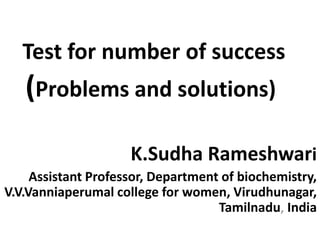
Test for number of success-Problems and Solutions
- 1. Test for number of success (Problems and solutions) K.Sudha Rameshwari Assistant Professor, Department of biochemistry, V.V.Vanniaperumal college for women, Virudhunagar, Tamilnadu, India
- 2. Tests of significance for attributes • Attributes, we can find out the pressure or absence of a particular characteristics. • for example, in the study of attribute : literacy” a sample may be taken and people classified as literates and illiterates. • while testing the significance for attributes, binomial type of problem may be formed. • The presence of an attribute is taken as success ie P and its non-appearance as failure ie q.
- 3. Three tests 1. Tests for number of success 2. Test for proportion of success 3. Test for difference between proportion
- 5. Problems 1. In a sample of 400 population from a village, 230 are found to be eaters of vegetarian items and the rest non- vegetarian items. Can we assume that both vegetarian and non vegetarian food are equally popular?
- 7. Since the difference between observed and excepted number of vegetable eaters is more than 1.96 SE at 5% level of significance. So, the hypothesis is rejected or not supported. We concluded that both vegetarian and non - vegetarian
- 8. Problem-2: In a hospital, 620 female and 600 male babies are born. Do these figures confirm the hypothesis that males and females are born in equal number? Solution: Let us take hypothesis that male and female babies are born in equal number ie p=q=1/2 ;n=1220 Therefore, the excepted frequencies of male and female babies -1220/2 =610 Observed number of female babies =620
- 9. S.E of female babies =17.46 Difference between observed and excepted female babies=620-610 =10 Difference 10 --------------- = ------- =0.57 S.E 17.46 Since the difference between excepted and observed female babies is less than 1.96 SE at 5% level of significance, it can be concluded that the male and female babies are born in equal number.
- 10. Problem 3:
- 11. Problem 4:
- 12. Problem 5: A coin was tossed 400 times and the head turned up 216 times. Test the hypothesis that the coin is unbiased Solution : Let us take hypothesis that the coin is unbiased. On the basis of this hypothesis the probability of getting head or tail would be equal ie p=q=1/2 ; n=400 Observed number of heads =216 Expected frequency of head =400/2 =200
- 13. n=400; p=q=1/2 =10 Difference between observed of heads and expected number of heads =216-200 =16 Difference 16 --------------- = ------- =1.6 S.E 10 The difference between observed and expected number of heads is less than 1.96 S.E (5% level of significance). Hence the hypothesis is accepted and we conclude that the coin is unbiased
- 14. Problem 6: In 324 throws of a six-faced dice, odd points appeared 180 times. Would you say that the dice is fair at 5 percent level of significance Solution: let us take hypothesis that the dice is fair ie p=q=1/2 ; n=324 Observed number of odd points =180 Expected frequency of odd points=324/2 =162
- 15. n = 324 ; p=q=1/2 =9 Difference between observed number of odd points and expected number of odd points = 180-162 = 18 Difference 18 --------------- = ------- =2 S.E 9 The difference between observed and expected number of heads is more than 1.96 S.E (5% level of significance), the hypothesis is rejected . Hence we cannot say that the die is fair at 5% level of significance
- 16. Problem 7: A person throws 10 dice 5000 times and obtains 2560 times 4,5 or 6. Can this be attributed to fluctuations of sampling? Solution : Let us take the hypothesis that there is no significant difference in the sample results and the expected results Since the difference is less than 1.96 S.E at 5% level of significance the hypothesis holds true. Hence the difference could be attributed to fluctuations of sampling.
- 17. Problem 8: A coin is tosses 10000 times and the head appeared 5195 times. Would you consider the coin biased. Solution : Let us take hypothesis that the coin is unbiased. On the basis of this hypothesis the probability of getting head or tail would be equal ie p=q=1/2 ; n=10000 Observed number of heads =5195 Expected frequency of head =10000/2 =5000
- 18. n=10000; p=q=1/2 =50 Difference between observed of heads and expected number of heads = 5195-5000 = 195 Difference 195 --------------- = ------- =3.9 S.E 50 The difference between observed and expected number of heads is more than 1.96 S.E (5% level of significance). Hence the hypothesis is rejected and we conclude that the coin is biased
- 19. Problem 9: In a hospital 480 female and 520 male babies are born in a week. Do these figures confirm the hypothesis that males and females are born equal number Solution :Let us take hypothesis that the male and female babies are born in equal number ie p=q=1/2 ; n=1000 Observed number of male babies =520 Expected frequency of male babies =1000/2 =500
- 20. =15.81 Difference between observed and excepted number of male babies are born=520 -500 =20 Difference 20 --------------- = ------- =1.265 S.E 15.81 The difference between observed and expected number of male babies is less than 1.96 S.E (5% level of significance). Hence the hypothesis is accepted and we conclude that the both male and female babies are born in equal number
- 21. Problem 10: In a 600 throws of a six-faced die, odd points appeared 360 times. Would you say that the die is fair at 5% level of significance? Since the difference is more than 1.96 at 5% level of significance , the hypothesis is rejected . Hence we cannot say that the die is fair at 5% level of significance
- 22. References • Statistical methods –Dr.S.P.Gupta • Statistical methods for biologists (Biostatistics)- S.Palanichamy & M.Manoharan